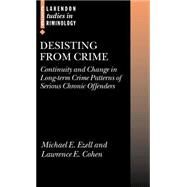Desisting from Crime Continuity and Change in Long-Term Crime Patterns of Serious Chronic Offenders
, by Ezell, Michael E.; Cohen, Lawrence E.- ISBN: 9780199273812 | 0199273812
- Cover: Hardcover
- Copyright: 2/17/2005
This groundbreaking study examines patterns of offending among persistent juvenile offenders. The authors address questions that have been the focus of criminological debate over the last two decades. Are there are multiple groups of offenders in the population with distinct age-crimepatterns? Are between-person differences in criminal offending patterns stable throughout the offender's life? Is there a relationship between offending at one time and at a subsequent time of life, after time-stable differences in criminal propensity are controlled? Ezell and Cohen address these issues by examining three large, separately drawn samples of serious youthful offenders from California. Each sample was tracked over a long time-period, and sophisticated statistical models were used to test eight empirical hypotheses drawn from three major theories ofcrime: population heterogeneity, state dependence, and dual taxonomy. Each of these three perspectives offers different predictions about the relationship between age and crime, and the possibility of crime desistance over the life of serious chronic offenders. Despite the serious chronic criminality among the sample offenders, by the time they reached their mid- to late twenties and continuing into their thirties, each of the six latent classes of offender identified by the study had begun to demonstrate a declining number of arrests. This finding hasprofound implications for penal policies that impose life sentences on multiple offenders, such as the Californian 'three strikes and you're out' which incarcerates inmates for 25 years to life with their 'third strike' conviction, at precisely the point when they have begun to grow out of seriouscrime.






